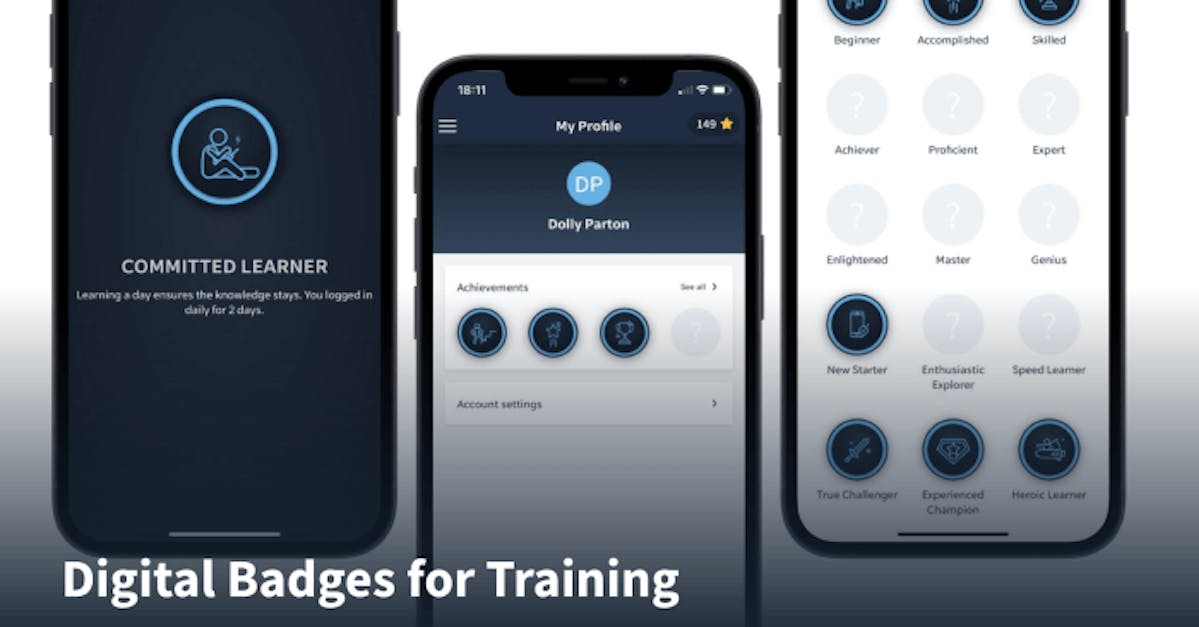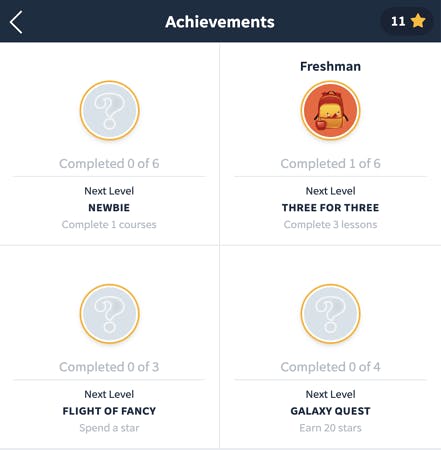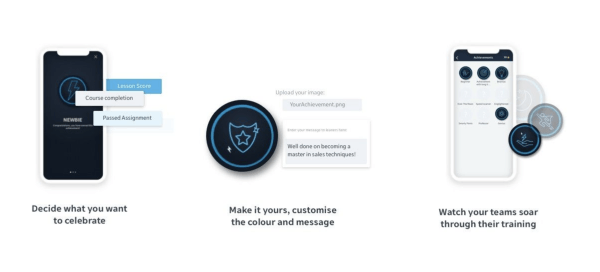Digital Badges for Training

Nothing motivates us quite as much as a perspective of a reward. From a bowl of ice cream at the end of a difficult meeting to a promotion at work, our brains seek positive enforcement to push through difficult tasks. Whether in private or professional life, a sense of accomplishment and reward are vital for that final kick of dopamine which makes it “worth it”. In this article, we’ll explore the topics of motivation, achievement, and reward in the context of digital learning through digital badges for employee training.
The use of badges as a reward system
The correlation between extrinsic motivation and reward has been under psychological scrutiny for decades. So-called reward systems are located in the frontal lobe of our brains, along the dopamine pathways. Dopamine is a chemical substance – a neurotransmitter – responsible for our experience of reward and pleasure – for some, dopamine can be released while working out, for some after a good meal, for others after stimulating conversation with someone they like. Like how a psychologist will refer to the theory of motivation, using a reinforcer is key to shaping outcomes. The system of reward is triggered in certain situations – it means it can be trained to release dopamine in response to certain motive or stimuli. Such correlations are popularly called positive reinforcement – our brain correlates the sense of reward with a sensation, a feeling, a state. Positive reinforcement is widely known to feed motivations. Even with self-determination, with our eyes on the reward and chemical associations built in our brains, we are more likely to make effort to achieve our goals if there is a motivational reward or incentive waiting for us at the other end.

This psychological process has been in use in various environments for thousands of years to motivate the members to give their best performance. Starting from the ancient Olympic games, through the medieval knighthood, signatures of position, to the modern orders, medals, and Scout badges, physical symbols of achievement have made it to today’s work environments. The idea of a badge has been in use for several decades and supposedly originated in the Soviet army. Every former member of scout groups surely remembers striving to receive a merit badge and later wearing it proudly on their uniform. Badges were not very valuable in terms of their material forms – rather, thanks to the achievement and struggle they represented. Similarly, badges proved to be a useful tool to motivate school students to perform better.
The value of digital badges in an online learning environment
The emergence of online learning spaces has created space for the introduction of so-called digital badges. It’s a fairly recent development in the online learning industry which came into use based on research on gamification. Gamification is a strategy used in teaching, which employs game design elements to enhance the outcome of teaching. Such elements can include points, teammates, avatars, leaderboards, and others. Gamification is geared towards designing a more competent, efficient, interactive, and rewarding elearning experience. It gives autonomy to the learning process, which is effective when evoking curiosity and motivating students and employees. Experts say that gamification of the learning process can enhance user engagement, organizational productivity, flow, social learning, crowdsourcing, or knowledge retention (Hamari 2019, p. 1-3). Digital badges are another vital game design element that can promote engagement, good grades, employee motivation, and positive reinforcement in users.

According to Shields & Chugh: “digital badges are quickly becoming an appropriate, easy and efficient way for educators, community groups and other professional organizations to exhibit and reward participants for skills obtained in professional development or formal and informal learning” (2017, p. 1817). Reward system oriented around merit badges has proven to be quite successful among online learners, also in corporate environments. As they are usually performance-based, they do not necessarily have to denote certain measurable achievements, such as completing an online course. Digital badges can promote consistency, dedication, the introduction of a new blended-learning and mobile learning elements, or teamwork. As such, badges do not encourage unhealthy competition, nor focus on differences in the learning capabilities of employees.
Awarding digital badges through Achievements
At EdApp, one of the leading online learning platforms offering tailored courses to a wide variety of industries, successful gamification of the learning process remains one of the key objectives. Lately, the platform introduced its latest development: Achievements. The feature follows the psychological correlation of intrinsic motivation and extrinsic rewards and is based on the notion of positive reinforcement. According to the creators, Achievements play the role of external motivator which helps learners to complete the game. Adding this element to the game is also proven to enhance message retention – meaning that the learners will most likely remember more from the game once they know they will be rewarded at completion.

Gamification badges are the core element of the Achievement feature. At EdApp, gamification badges and banners are fully customizable which allows course creators to apply them in the format that suits the course and learners best. The course creator is offered this feature through the Engagement feature on the learning management system. Here, they can adjust the content and frequency at which the badges will appear. Just like the authoring tool, the application of digital badges is simple and intuitive. The basic design is provided and it’s up to the creator to spice it up according to their needs. Later digital and badges with your message will appear in appropriate spots.
How effective are digital badges?
It’s all good and nice – but are digital badges efficient? After all, we’re not school children anymore and no colorful paper medals should motivate us to do better. Well, research says, it’s quite the opposite. The external rewards systems in the human brain work the same regardless of age. The perspective of a prize stimulates our dopamine pathways in the same manner whether we’re 10 or 40. Digital badges are a simple yet brilliant step to encourage the performance of the learners by showing appreciation and providing visibility for their achievements. Gamification of the learning process, through its interactive, participatory, and competitive character, creates space for positive reinforcement strategies and merit badges, well-known to most from their childhood, fit in this role perfectly.
Author
Guest Author Marta Rudnicka
Marta Rudnicka is a creative content writer with vast experience in writing, editing, translation, and data analysis. Aside from writing, their interests are centered on mental health, human rights, travel, and environmental concerns.
